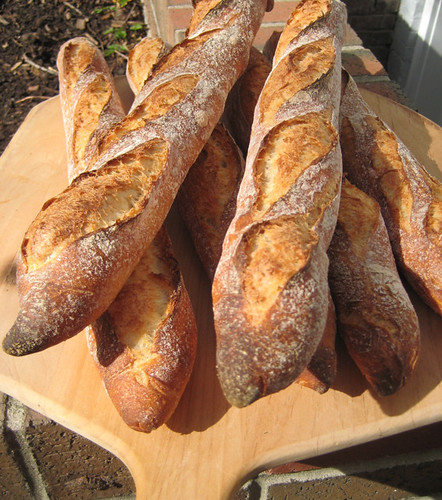By Samuel Fromartz
Once in awhile, when you put a lot of work into a task and actually get a decent result -- well, you get to gloat, at least for a few minutes. So excuse me while I do so, because my humble, home-made baguettes just topped every bakery in Washington, D.C., in a blind tasting competition.
On the one hand, this result was unexpected. I mean, I’m a writer by profession. I’ve always been a writer, well, almost always. But I love to cook too, and at times have become passionate about it. I’m also drawn to crafts, and to crafts people; whether the craft is putting words together or making a whole grain sourdough loaf.
But in distinction to writing, baking has been a private endeavor. It was just something I did to break the tension, when my arms tensed up from typing too much, or when I just wanted to leave the computer screen and do something with my hands -- to make something tactile.
This grew into a regular practice. Starting many years ago, I stopped buying bread, because I made enough. A few loaves a week, we’d eat one and another would go into the freezer. I became adept at sourdough, using the natural yeast present everywhere. It was like conjuring something out of thin air.
My motivation was simple. I just wanted good fresh bread. Who can argue with that? It wasn’t a business. There was no market to worry about, no bosses or rent, nothing. Just baking pure and simple without any distraction because I had absolutely no larger intention. It was pure craft.
The parameters of the task were clear and challenging. You have just four ingredients: water, flour, yeast and salt. So often, we think of all the stuff or things we need to do something -- the equipment, the newest gizmo. And I did buy a few things, like bench scrapers and a couche (a linen cloth to support the shape of baguettes) and a baking stone to try and mimic the conditions of a hearth oven. But that was pretty much it, not much more than $100 over, what, a decade? Plus the ingredients, like flour, seeds, walnuts - or whatever else I choose to put in the loaves.
Then, there was the baguette itself, which is deceptively simple and hard to master. There’s the soft, slightly sweet crumb, the uneven and slightly chewy and bubbly interior, the crisp crust, delicately toasted in sections, and the aesthetic appearance, which comes from the slashes running down the top of the loaf.
When I began baking, this was the first bread I tried to make. It was an absolute failure, too dense, tasting of yeast and lacking a crisp exterior. I tried many times to make it, then just gave up. Decided it couldn’t be done at home. I went on to bake other loaves and over the years learned a lot more. I could have condensed this process had I even taken a few baking classes, but I didn’t. I learned from cookbooks and developed the technique on my own (since baking is more about technique than a recipe -- again the craft of it).
But the allure of the perfect baguette was always there, so I’d go back to it now and again, but never approached what I thought even a half decent loaf should be.
The breakthrough first came maybe two years ago with a sourdough baguette, which I let rise in the refrigerator overnight. I was somewhat surprised by the results, since I had finally achieved the interior bubbly structure I sought. So for a while I stuck with those loaves, thinking they were pretty close to what I wanted.
But then I thought, to really be a baguette, the loaf should be lighter. With the aid of a Peter Reinhart recipe, I made a loaf without any sourdough. It had the bubbly structure, but I felt the taste wasn’t quite on par with sourdough. He also used bread flour, which I felt it was too strong, leaving the interior crumb too chewy, so I switched to all purpose flour -- a misnomer because it really tells you nothing about what you're using. The actual flours I bake with -- King Arthur Unbleached Organic All Purpose Flour or Whole Foods 365 Organic All Purpose Flour -- were ideal because they are both made with hard winter wheat suited to artisan loaves.





